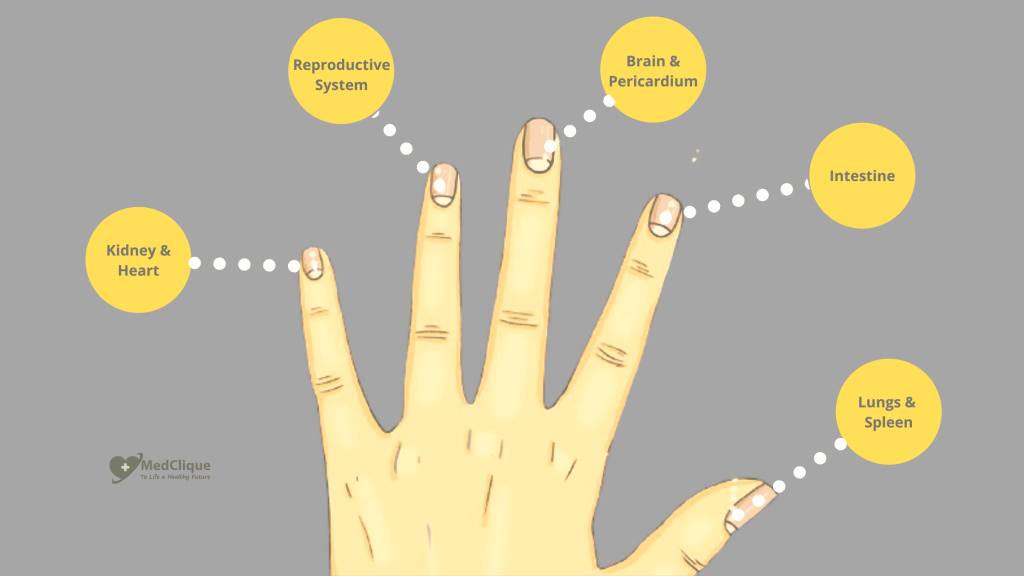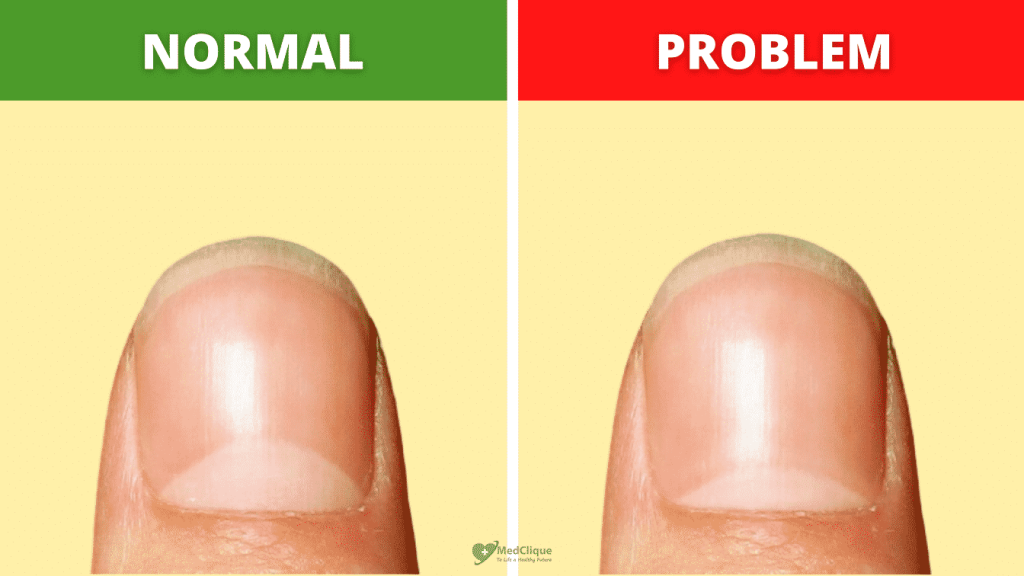If you look at your nails, you’ll likely see a little semicircle of slightly pale skin at the base of each one. These half-moon shapes on nails are called lunulae – a Latin word, meaning “Little moon”. They cover the bottom of your nail, just above your cuticle.
Here, read on to learn more about what these half-moons on nails look like, when their appearance could be cause for concern, and when to see your doctor.
The appearance of a half-moon on nails
It’s a very delicate part of the nail, and damage to it can leave the nail permanently deformed.
The nail consists of a matrix which refers to the tissue just beneath your nail. Lunulae are part of that matrix.
The matrix refers to It contains nerves, lymph, and blood vessels. This area of the nail also produces the cells that become the hardened nail plate, which is what you see.
Although everyone has lunulae on nails which define the shape of your fingernail, not everyone will see or have it on each nail. Those who do have a lunula may notice that they vary in appearance across each nail.
According to experts, it can relay secrets about the overall health of the individual. They not only indicate the presence of a disease but also the predisposition to it.
What healthy Lunulae look like?
Usually, healthy lunulae look whitish in color. They are most visible on your thumb and take up a small portion of the bottom of your nail.
On other fingers, they appear smaller on your pointer finger, gradually shrinking in size until you reach your small finger.
Some sources suggest that lunulae may signal issues with the cardiovascular system, heartbeat disruption, and low blood pressure.
These lunulae change their color, shape, or size as per the health status of your body.
What if half-moon on nails are large?
Lunulae are considered large when they occupy a third (or more) of the fingernail. Though it is still unclear why the lunula takes up a significant portion of the nail.
Large lunulae can be often found in athletes and people whose occupation is connected with physical activity. This may be due to the bodily stress associated with high-impact activities, but there is currently no research to back up these claims.
It is believed to be indicative of high blood pressure and a possibly overworked heart. If a person isn’t involved in sports, enlarged lunulae may appear because of a high level of stress.
Identifying the triggers of stress, consider rearranging things to be less of a strain. Relaxation techniques like meditation may help you relieving stress.
What if half-moon on nails are small?
Small lunulae can be barely seen behind the cuticle, they might be hidden underneath the cuticle or skin at the base of your finger.
Usually, smaller lunulae aren’t causing concern, but in some cases indicate low blood pressure and circulatory disorders.
Small moons that barely come over the surface of your cuticle can be a sign of low energy, low blood pressure, lack of iron, or Vitamin B12. They can also be a sign of a weakened immune system or poor metabolism.
You should try getting more sleep and eating enough healthy food and nutrients to boost your energy. Intake of proper vitamin or iron supplements will help fighting low energy levels.
What if half-moon on nails are missing?
It is not a danger sign or does not mean that something is wrong with your health. Sometimes, you may only be able to see lunulae on your thumbs or possibly not on any fingers at all.
In these cases, the lunula is most likely hidden under your skin – chances are, if you can’t see your moons, they are there, but they’re just under your cuticles.
The missing lunulae may be a result of trauma or a sign of anemia, malnutrition, or depression.
However, a sudden disappearance of lunulae is perceived by modern medicine as one of the symptoms of a circulatory disorder.
Make an appointment with your doctor if you’re experiencing any of the following symptoms along with an absence of lunula:
- Fatigue, weakness, or dizziness
- Significant weight gain or weight loss
- Loss of interest in your favorite activities
If you don’t find lunulae on your child’s nails, they may appear over time. In some people, they don’t appear at all due to physiological specificities of the nail structure.
Yellow nail syndrome
This condition typically produces thick, slow-growing nails. The middle of your nail may begin to rise, causing the lunulae to disappear completely (1).
There is enough possibility of chronic sinusitis, rheumatoid arthritis, or immunodeficiency disorders in this syndrome.
Terry’s nails
This condition causes the bulk of your nail to appear white, completely erasing the appearance of the lunulae. Although it can happen on one finger only, it usually affects all fingers.
In older adults, this condition is usually a natural sign of aging. In some cases, it may be a sign of diabetes, liver disease, or kidney failure.
What if half-moon on nails are separated?
It could be a possibility that lunulae found separated from the rest of the nail plate with transverse lines, it indicates problems with blood sugar levels and the possible development of diabetes.
Please get the sugar profile done periodically in consultation with your physician.
Sometimes, the appearance of your lunula or overall nail can be a sign of an underlying condition:

A lunula on the little finger could be almost unnoticeable or completely absent. It’s connected with the work of the kidneys, small intestine, and heart. An increased lunula can be a result of high blood pressure (2).
The ring finger lunula is responsible for the work of the reproductive and lymphatic systems. A barely visible lunula can hint at digestion problems.
The middle finger lunula is connected with the work of the brain and the cardiovascular system. The absence of a lunula can indicate vascular problems and high blood pressure.
The index finger lunula can disappear or get considerably smaller because of the improper function of the intestine, pancreas, or chronic E.N.T. diseases.
The lunula on the thumb reflects the work of the lungs and spleen. It’s the most visible of all and should take up no more than 25% of the whole fingernail. It can get significantly smaller in smokers or bigger when you have arterial hypertension.
What does the color of a half-moon on nails signify?
Here are some of the most common reasons for abnormal half-moon on nails or lunulae:
Yellow
Tetracycline medications are antibiotics that are usually used to treat acne and skin infections. Extended use may cause your lunulae to turn yellow. Yellow nail syndrome causes half-moon on nails to look yellowish in color.
Pale Blue
Pale blue lunulae may be a sign of undiagnosed or uncontrolled diabetes. This is a chronic, lifelong condition that affects the body’s ability to control blood sugar.
Blue
If you are diagnosed with a rare inherited disorder called Wilsons disease, it causes lunulae to turn blue. It occurs due to too much copper accumulation in your organs.
Brown or black
Taking in too much fluoride (excessive ingestion), like that found in toothpaste, can turn the lunulae brown or black.
People who experience chronic renal failure may produce more melanin, which can cause your nail bed to turn brown.
Black
Black lunulae are an uncommon and extremely dangerous sign. As a rule, this is a symptom of heavy metal poisoning.
Gray
It indicates severe fatigue, digestion disorders, and possible difficulties in nutrient absorption.
Purple
The color is a sign of poor blood circulation and a lack of oxygen in the organs and tissues. Dizziness and headaches may often occur.
Pink or red
They may indicate low physical activity and lung problems. It can be a signal of heart failure as well. Terry’s nails is a condition where your half-moon on nails can appear pink or red.
Takeaway
If you’re not seeing lunulae, or if you’re seeing changes to the shape or color of your half-moons on your nails along with other symptoms, seek medical attention immediately.
They’ll make sure you don’t have an underlying health condition that needs to be treated.
You must read:
